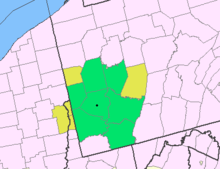
The Mother Bethel African Methodist Episcopal Church is a historic church and congregation which is located at 419 South 6th Street in Center City Philadelphia, Pennsylvania, USA. The congregation, founded in 1794, is the oldest African Methodist Episcopal congregation in the nation.
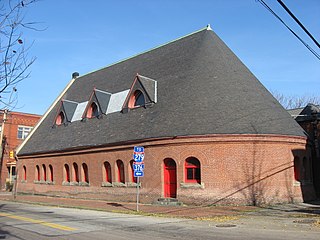
Emmanuel Episcopal Church is a church in the North Side neighborhood of Pittsburgh, Pennsylvania. Located at 957 West North Avenue at the corner of Allegheny Avenue, its 1886 building is known for its architectural features and was one of the last designs by Henry Hobson Richardson. It was declared a National Historic Landmark in 2000. An active parish of the Episcopal Diocese of Pittsburgh, it is known for offering a Sunday evening service of Jazz Vespers.

St. Mark's Episcopal Church, now the Episcopal Parish of St. Mark and St. John, is a historic Episcopal church at 21 Race Street in Jim Thorpe, Carbon County, Pennsylvania. Completed in 1869, it is a prominent example of Gothic Revival architecture designed by that style's leading proponent, Richard Upjohn. It is one of Upjohn's last designs, and was funded by the congregation, which contained eight millionaires whose fortunes were made in the coal fields and railroad industry. It was added to the National Register of Historic Places in 1977, and declared a National Historic Landmark in 1987.
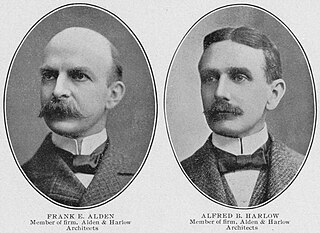
Longfellow, Alden & Harlow, of Boston, Massachusetts, and Pittsburgh, Pennsylvania, was the architectural firm of Alexander Wadsworth Longfellow Jr. (1854–1934), Frank Ellis Alden (1859–1908), and Alfred Branch Harlow (1857–1927). The firm, successors to H. H. Richardson, continued to provide structures in the Romanesque revival style established by Richardson that is often referred to as Richardsonian Romanesque.

Bethel AME Church, now known as the Central Pennsylvania African American Museum, is a historic African Methodist Episcopal church at 119 North 10th Street in Reading, Berks County, Pennsylvania. It was originally built in 1837, and is a 2½-storey brick and stucco building with a gable roof. It was rebuilt about 1867–1869, and remodeled in 1889. It features a three-storey brick tower with a pyramidal roof topped by a finial. The church is known to have housed fugitive slaves and the congregation was active in the Underground Railroad. The church is now home to a museum dedicated to the history of African Americans in Central Pennsylvania.

The Methodist Episcopal Church of Burlington, also known as the "Old Burlington Church," is an historic, American Methodist Episcopal church that is located on US 6 at Township Road 357 in West Burlington, Bradford County, Pennsylvania.

St. Mary's Episcopal Church, also known as Old Saint Mary's Church, is a historic Episcopal church located on Warwick Road, Warwick Township in Elverson, Chester County, Pennsylvania. The church was built in 1843, and is a one-story, rectangular stuccoed fieldstone structure in the Gothic Revival style. It measures 50 feet wide and 70 feet deep. The church is surrounded by the parish cemetery, with burials dating to 1806.

Frederick C. Sauer was a German-American architect, particularly in the Pittsburgh, Pennsylvania, region of the late 19th and early 20th centuries.

The Dilworth Elementary School in Pittsburgh, Pennsylvania, is a historic school building, completed in April 1915. As of March 2015 it is a traditional Magnet school for pre-kindergarten through the fifth grade in the Pittsburgh Public Schools system. It was listed on the National Register of Historic Places in 1986.
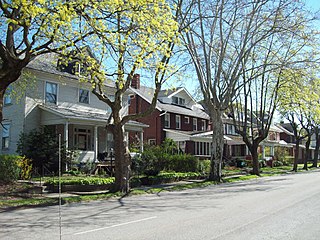
Broad Avenue Historic District is a national historic district located at Altoona, Blair County, Pennsylvania. The district includes 140 contributing buildings in a residential area of Altoona. The buildings were primarily built between 1880 and 1927, and reflect a number of popular architectural styles including Colonial Revival and Italianate. The area was developed as an early streetcar-oriented development in Altoona. Non-residential buildings include the Broad Avenue Presbyterian Church and Broad Avenue United Methodist Church (1927).

Downtown Altoona Historic District is a national historic district located at Altoona, Blair County, Pennsylvania. The district includes 240 contributing buildings in the central business district and surrounding residential areas of Altoona. The buildings were primarily built after about 1860 and include residential, civic, social, and religious buildings. Although it does not encompass the entire downtown, it is for the most part the most urban part of Altoona's downtown district. Notable buildings include the Cathedral of the Blessed Sacrament (1920s), First Methodist Episcopal Church, First Presbyterian Church, First Evangelical Lutheran Church (1896-1897), U.S. Post Office (1931-1933), Fraternal Order of Eagles Building (demolished), Altoona City Hall, Casanave Building (1890s), Hutchison Block, McCrory's Department Store (1937), and Aaron-Penn Furniture Building. Located in the district are the separately listed Central Trust Company Buildings, Mishler Theatre, and Penn Alto Hotel.

The Hollidaysburg Historic District is a national historic district which is located in Hollidaysburg, Blair County, Pennsylvania.
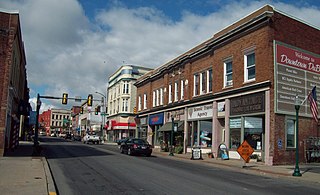
Dubois Historic District is a national historic district located at Dubois, Clearfield County, Pennsylvania. The district includes 54 contributing buildings in the central business district of Dubois. The district consists of mostly commercial buildings built after the fire of 1888 and in a variety of popular architectural styles including Gothic Revival architecture, Italianate, and Romanesque Revival. Notable buildings include the Hatten & Munch Building (1897), Moore & Schwern Building, Methodist Episcopal Church (1889), First Baptist Church (1891), Shaw Building (1895), and DuBois Public Library (1923). Located in the district and separately listed was the Commercial Hotel.
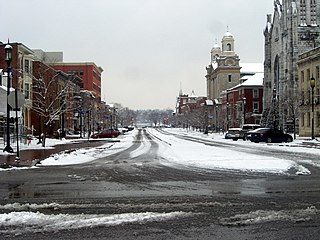
The Harrisburg Historic District is a national historic district which is located in Harrisburg, Dauphin County, Pennsylvania.

The Milton Historic District is a national historic district that is located in Milton, Northumberland County, Pennsylvania.

The Union Methodist Episcopal Church, also known as the Jones Tabernacle AME Church and Parish House, is an historic, American Methodist Episcopal church and parish house that is located in the North Central neighborhood of Philadelphia, Pennsylvania.

Tindley Temple United Methodist Church, also known as Tindley Temple Methodist Episcopal Church and Calvary United Methodist Church, is a historic Methodist Episcopal church located in the Southwest Center City neighborhood of Philadelphia, Pennsylvania. It was built between 1923 and 1928, and is a large masonry building influenced by the Beaux-Arts Romanesque and Art Deco styles.

Queen Anne Historic District is a national historic district located in Reading, Berks County, Pennsylvania. The district encompasses 2,405 contributing buildings in Reading built between about 1880 and 1925. The district consists primarily of semi-detached houses and rowhouses, with a few stone church buildings and small commercial buildings. Most of the buildings are constructed of brick and reflective of Late Victorian and early 20th-century architectural styles. The churches are St. Mary's Episcopal Church (1904) and Wesley United Methodist Church (1922). Located in the district and separately listed are the Charles S. Foos Elementary School and former Meinig Glove Factory-E. Richard Meinig Co.

The Montrose Historic District is a national historic district located in Montrose, Susquehanna County, Pennsylvania. The district encompasses 386 contributing buildings and two contributing sites in the central business district and surrounding residential areas of Montrose.
























